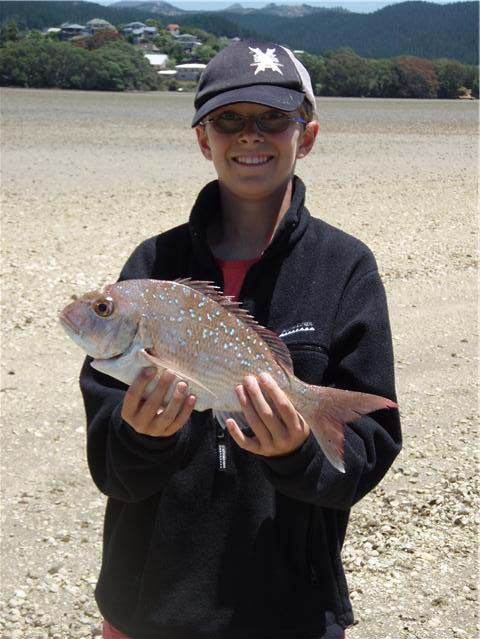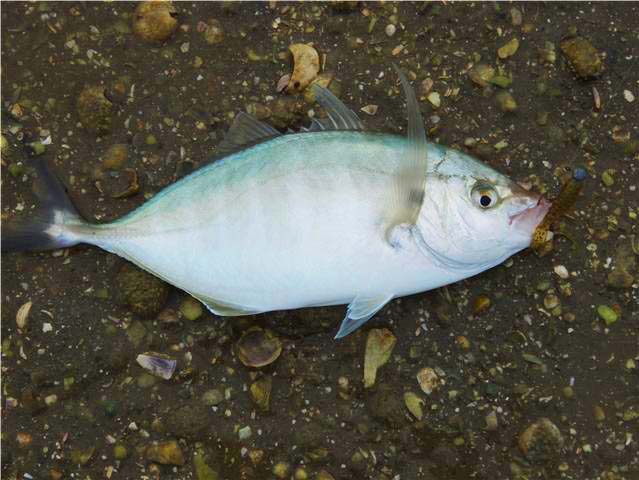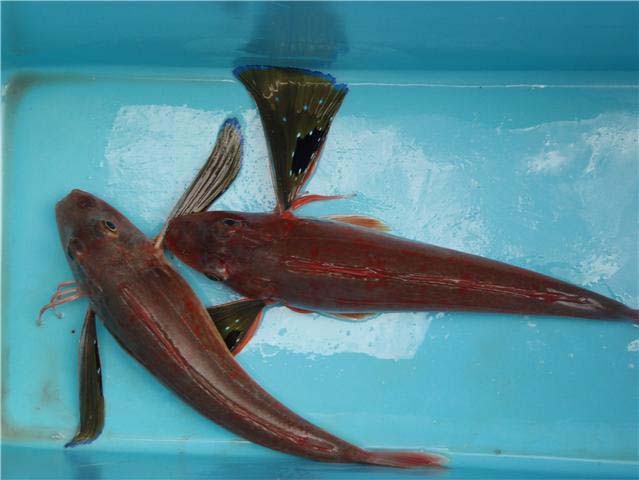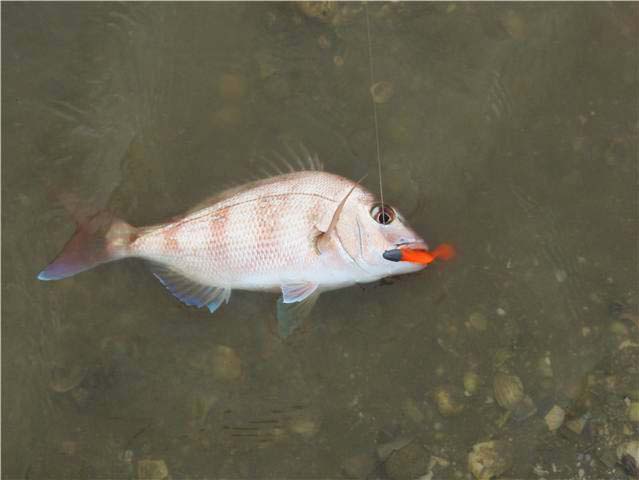

Catch Fish with
Mike Ladle
Information Page
SEA FISHING
For anyone unfamiliar with the site always check the FRESHWATER, SALTWATER and TACK-TICS pages. The Saltwater page now extends back as a record of over several years of (mostly) sea fishing and may be a useful guide as to when to fish. The Freshwater stuff is also up to date now. I keep adding to both. These pages are effectively my diary and the latest will usually be about fishing in the previous day or two. As you see I also add the odd piece from my friends and correspondents if I've not been doing much. The Tactics pages which are chiefly 'how I do it' plus a bit of science are also updated regularly and (I think) worth a read (the earlier ones are mostly tackle and 'how to do it' stuff).
Christmas down under.
Apart from a stinking cold I didn't catch much over the Christmas holiday but things were different down in New Zealand. My pal Alan sent me a long account of his fishing trips over the festive season. I felt suitably envious and I thought that they'd be of interest to anyone so here they are:-
Hi Mike,
As promised, please find below a summary of my fishing activities while at Whangamata over the Christmas/New Year period. I only missed fishing on two of the nine days which was a fair effort, given the time of year and other commitments. Unfortunately low tide ended up being between 9am and 4.00pm during my stay which effectively scuttled late evening fishing and meant that I was out on the estuary in the mid day heatHeat? What's that? ML. Mudflats in summer are an inhospitable place when the sun is high in the sky as the reflected light, coupled with the heat from the sand, makes it very unpleasant. The only respite is from the ever present breeze. If the breeze gusts 5 – 15 knots then conditions are altogether more comfortable.
BOXING DAY
We arrived in Whangamata just before lunch which gave me plenty of time to unpack the boat and get ready for a late evening mudflat fishing sortie. Low tide was at 9.30 pm. which meant that I could tackle up after dinner and spend a leisurely two hours on the mudflat at dusk. The day had been warm (25oC) but as the evening unfolded a fresh breeze of around 10 knots sprang up from the NNE which provided welcome relief from the late afternoon heat. We’d been boogie boarding earlier in the afternoon on the surf beach and the water was unseasonably cold. On second thoughts cold is a charitable description, as it was bloody frigid.
Hamish decided that he’d accompany me onto the mudflats and we set off from the car park at 7.30 pm. Stomachs full from traditional Christmas fare we waddled across the flats to the main channel. I noticed on the way out that there was a lot of snapper sign, as evidenced by the holes they leave when fossicking for crabs, so I rigged soft plastics on both rods. I opted for a PowerBait minnow on a ½ oz. jig head and selected an Orange Sassy shad on a ½ oz. jig head for Hamish. I directed Hamish to the most promising lie and set off downstream prospecting the channel margins as I went. I would not have gone 50 metres when Hamish (all 6’1” and 90 kilograms of him) decided he needed more distance and put his full bulk behind casting the lure. The tortured crack of splintering graphite was readily audible as the rod tip set off to land mid stream in the estuary while the butt section remained in his hands. Given that the rod was originally a one piece 7’ spinning model the fact that it now had three pieces represented a slight problem! The rod was a rebuild so the breakage was not too expensive and it gave me something to do repairing it over the next couple of days.
Refusing the offer to carry on with my rod while I stood behind him, Hamish sat dejectedly on the sand watching me fish. I decided at this point that going home was the best option so we set off after less than 30 minutes on the estuary.
27 DECEMBER 2009
Eager to make up for the aborted session the previous evening, I was on the estuary alone at 7.45am the following morning. Conditions were perfect. The sky was postcard blue, smeared with streaks of cotton wool and a moderate breeze from the West. At Whangamata, “West is best” as it is gusting directly behind the angler which helps propel the lure well across the estuary. I opted to start fishing with a Yo-Zuri 3D bibless minnow to see whether there were any kahawai present. This was a good choice and I proceeded to extract and release 3 small (15”) kahawai in the first 40 minutes of the session. Unfortunately things slowed appreciably after the promising start and I failed to hook any fish in the next ¾ of a hour. In desperation I switched to a PowerBait minnow on a 1/8 oz. jig head and flailed away with this for 30 minutes. Nothing doing. I changed back to the Yo-Zuri minnow at dead low tide and promptly hooked and landed another small kahawai.
The lack of success on the soft plastic lure was very surprising given the profuse snapper sign so I obviously needed to change tactics for subsequent sessions.
28 DECEMBER 2009
The day dawned overcast and the conditions were variable as I headed out onto the estuary at 8.40 am. The weather was fine with a gusty 10 knot zephyr from the South. Occasionally things would take a turn for the worse as a squall of sea fret wafted through. The misty rain was similar to fog and certainly not heavy enough to require a jacket. I opted to start with a 3” whirl tail worm rigged on a ¼ oz jig head (Salt & Pepper colour) in an effort to winkle out a snapper. My first cast arched out across the still water dropping nicely on the edge of a current seam and within two rod tweaks it was devoured by a hard running 2 lb trevally. This fish hit the afterburners and charged away on a withering run before deciding that dogged resistance in the margins was the best plan to fight the incessant rod pressure. It succumbed within 5 minutes and was photographed before a quick release. The lure can be clearly seen in the attached photograph.
Two small kahawai also fell prey to the whirl tail in the next 30 minutes but no snapper were tempted. As the tide flow began to slacken the whirl tail seemed to lose effectiveness so I switched to a small deep diving bibbed minnow (2”) of uncertain parentage. This lure blanked for 25 minutes so I opted to change to the ever reliable Yo-Zuri 3D bibless minnow. The change to the Yo-Zuri lure coincided nicely with my arrival at the confluence of the side stream and the main channel. There were lots of tiny bait fish in the margins and there was the odd larger fish swirling outside on the edge of the channel proper. My first cast landed ¾ of the way across the estuary and within two cranks was monstered by a hard running, feisty kahawai of around 1½ lb. This fish charged up and down the estuary parallel to the shore for a couple of minutes before being drawn to the shore by rod pressure. The next 30 minutes was a case of “Groundhog Day” as every second cast was spanked by a kahawai of comparable dimensions, each of which fought almost identically to the first fish.
Eventually the action abated and I made my way back to the car at 10.40 am. Nine fish in 2 hours was a much better return on effort invested.
29 DECEMBER 2009
Low tide was scheduled for 11.10am. so I made my way onto the estuary at 8.50am determined to catch an elusive snapper. A neighbour had mentioned overnight that he’d been catching 32 cm. Snapper regularly in his set net (Ba*ta*d) so this confirmed they were present and the sign on the mudflats was in fact snapper as suspected. Conditions were similar to the previous day although there was only one sea fret event during my time on the water. The wind had swing around to the W overnight and this was a major bonus as it bolstered casting distance. Again I started with a 3” whirl tail worm rigged on a ¼ oz jig head (Salt & Pepper colour). Unlike the previous days I cast further upstream (10 O’clock) and mended the braid to allow the lure to sink and drift in an arc with the current. Every tap on the bottom was transmitted through the braid and it was not long before a small kahawai spanked the lure as it rose up the side of the main channel. This fish fought spiritedly but was no match for the 8’ graphite spinning rod and was swiftly returned. I persisted with the whirl tail for another 30 minutes and then decided to swap it for an Orange Sassy shad. This would sink a little slower and have a totally different swimming action, one that in the past trevally and snapper both found irresistible.
Second cast with the Sassy shad sailed well out into the channel and as I made an upstream mend the line suddenly went taut as a fish hit the lure on the drop. This was no kahawai. It went deep and shook its head vigorously in anger...snapper! It headed out into the middle of the estuary before making a determined run parallel to the shore downstream. I managed to turn its head and beach the fish before it realised that it had run out of water. At 30 cm it was not big enough to keep so I took it’s photograph (lit up in full glory) and let it go. Needless to say no other snapper were tempted to the sassy shad over the next 30 minutes so I changed lure to a 3” PowerBait on a 1/6 oz jig head (the tide flow had slackened appreciably by now) and re-positioned myself at the confluence of the side stream and the main channel.
First cast upstream with the PowerBait was halted mid stream by a solid strike and line sped of the reel as another head shaking snapper charged off into the deep water. This fish again made the mistake of running parallel to the shore, rather than slugging it out deep, and was quickly horsed into the shallows. At 29 cm it was the virtual mirror image of the first fish so was again released. Nothing else came to the soft plastic over the next 30 minutes so I opted to switch to the Yo-Zuri 3D bibless minnow for the last 30 minutes before dead low tide.
As with the previous day this was an inspired choice as six 15” kahawai fell to the lure in half an hour. Four came from successive casts into a shallow gut. The casts were made upstream at between 9 – 10 O’clock and a single rip as the lure descended through the water column was enough to entice the strike. Interestingly I’d switched the treble hooks on the bibless minnow for uniquely designed Japanese single hooks (the eye of the hook is parallel to the shank rather than perpendicular to it) and these did not seem to compromise performance in any way. (Good idea for most lures eh! ML)
31 DECEMBER 2009
The day dawned brilliantly fine with only the faintest wisp of cloud to interrupt a clear blue sky.(Doesn't it make you want to pewk? ML) The wind was again blowing from the West in 10 – 15 knot gusts. Low tide was 1.00 pm so I was out on the estuary ready to start by 11.00 am. Buoyed by the snapper success in my last outing, I decided to start with a PowerBait 3” minnow fished on a ¼ oz jig head. Casting slightly upstream. Mending the line as the lure dropped and keeping a tight line as the lure bounced in an arc to the shore lead to 6 small kahawai in just under an hour. The odd rod twitch seemed to improve effectiveness.
Working the PowerBait systematically downstream with the ebbing flow I idly noticed a couple in a blue kayak paddling towards me. The occupants were elderly and both had pony tails protruding from under wide brimmed Stetsons. Their clothing was lightweight cotton and it fluttered gently in the breeze. The male had a beard and was mumbling instructions in a Californian drawl to his companion. In another age they would probably have been known as flower children. My mind drifted and at precisely this point the PowerBait was absolutely spanked by an XOS trevally of around 7 lb. It took off towards the kayak just below the surface in a withering run then turned on its tail near the kayak and headed back upstream against the current. The line cut through the water and was straining to keep up with the turbo boosted fish. A bubble trail showed where the line was and it was well behind the fish. I was winding like a dervish to keep the line tight and maintain contact. The second run upstream was at least 60 metres and then the fish sounded. It sulked on the bottom and then charged off downstream again this time much closer to the shore. This see-sawing continued for about 10 minutes until it almost beached itself below me. The couple in the kayak were “oohing and aahing” at the performance as it was obvious from the bend in the rod that it was a good fish. We all saw it clearly as it nearly beached itself and then as it spun back into the current the hook pulled. I yelled a single expletive (rhymes with “Duck”) to which the spectators remarked “it’s always the good ones that get away sonny – better luck next time”. In hindsight I should have pulled hard when the fish was in the shallows as it may have been enough to get it onto the shells and give me a chance to kick it out.
Once I’d regained my composure I carried on downstream and landed 5 small kahawai on the PowerBait before calling it a day. No snapper hooked, even though I fished with a soft plastic for the entire session.
1 JANUARY 2010
We’d met up with some friends in Whangamata on New Year’s Eve and they have a son, Simon, who at age 12 is a mad keen fisherman. During the New Year’s celebration I offered to take Simon with me fishing on New Year’s day.
The day dawned brilliantly clear with a blue sky full of wispy horse’s tail clouds. The wind was gusting 20 knots from the NNE which is the worst possible direction for soft bait fishing as it is directly downstream. It is difficult to cast light jig heads upstream into the wind and also the wind blows a billow in the braid which makes it impossible to mend the line or keep in touch with the lure. Realising this I advised Simon to bring his bait fishing kit and some bait. Conditions when we reached the estuary were pretty marginal for soft baiting so I rigged up a ledger rig, attached a 2 oz sinker and got Simon fishing with trevally bait. First cast resulted in a 12” kahawai and then every subsequent cast either got snagged or resulted in another kahawai or a small snapper (8”). Simon had never had any tutoring so I was fully employed showing him how to cast, how to free snags (how to re-tie on rigs!) and how to handle the fish he caught. After about 1 ¼ hours of tuition he was at the point where he could “fly solo” so I left him to it and had a few casts with a soft bait upstream. In 10 casts I had three solid hits but could not connect with the fish because of the bow in the line. I was pondering what to do next when Simon started yelling and his rod was bent double. By the time I got to him he’d nearly landed a 3 lb snapper (34 cm) and I coached him through beaching the fish. Was he stoked? You bet he was (see the photograph). His biggest fish to date.
Simon did not want to fish any more (eager to get home to show off his catch?) so we spent the next 20 minutes spotting stingrays, small bait fish and the kahawai schools that were working the margins. Simon’s dad met us when we reached the car park and was gob smacked when he saw Simon’s fish. There is no doubt that Simon will keep fishing and he has all the skills (inquisitive mind and passion) to become an excellent fisherman. It was the highlight of the holiday for me and I could not have scripted a better outcome.
3 JANUARY 2010
The boys had by now headed off on holiday with Sandy’s parents (to an isolated town near East Cape) so we decided to take out the boat and fish outside of the harbour. The conditions were marginal (NE wind gusting 20 knots) but the chop was manageable if the boat was drifting and not anchored. I was keen to soft bait whereas Sandy wanted to soak bait. We motored North and opted to drift in the hope of picking up a school of snapper or gurnard. Once again I opted to start with a 3” whirl tail worm rigged on a 5/8 oz jig head (Salt & Pepper colour) as these lures are highly attractive to gurnard.
To cut a long story short, we drifted for around 2 hours and I caught three gurnard. One was returned and the other two (30 – 32 cm) posed for a photograph before joining us for dinner. Each gurnard took the soft bait as it lifted from the bottom and was neatly pinned through the top lip cartilage. To get the lure to the bottom it was necessary to cast about 30 – 40’ ahead of the boat, such was the speed of the drift. Very short drift cycle. It would have been madness to deploy a drogue in the conditions. Sandy had a couple of bites but unfortunately did not hook up and I spent around 30 minutes trying to show her how to use soft bait. There may be hope....!
Hope that the above gives you a picture of what I’ve been up to. Not many big fish but heaps of fun. Roll on our Whangapoua holiday in mid – Late January where Colin will be showing me how to use Gulp! effectively.
Tight lines and all the best,
Alan.
So, there it is, a wonderful New Year of fishing activity. I always feel that I learn a lot from Alan's emails and it is clear that when it comes to using soft plastics I'm a real novice. Obviously these baits are not the 'answer to an angler's prayer' but despite being a bit of an 'old dog' I shall be trying out a few new jigging tricks in 2010.
If you have any comments or questions about fish, methods, tactics or 'what have you!' get in touch with me by sending an E-MAIL to - docladle@hotmail.com
Simon's first decent fish.

Nice trevally.

Gurnard.

Good snapper.
